

« Avec Webedia, nous allons aider les marques à investir dans le digital » LA TRIBUNE - De TerraFemina à jeuxvideo.com, la trajectoire de Fimalac dans les médias numériques peut surprendre.
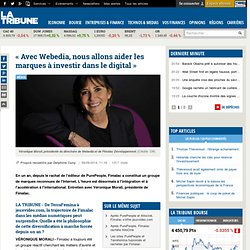
Quelle a été la philosophie de cette diversification à marche forcée depuis un an ? VÉRONIQUE MORALI - Fimalac a toujours été un groupe réactif cherchant les métiers d'avenir et les pépites. Je m'étais moi-même engagée dans l'aventure numérique en créant le site TerraFemina. Quand l'opportunité d'entrer au capital de Webedia s'est présentée, nous avons compris qu'elle était unique : Webedia nous a semblé une plateforme de départ extrêmement attractive pour nous déployer dans le digital à travers le divertissement, compte tenu de son expertise reconnue en tant que « media publisher » avec la galaxie de sites PurePeople, PureMedias, et son avance dans le « brand publishing ». Un an après la finalisation, qui a eu lieu fin juillet 2013, nous constatons que nous ne nous sommes pas trompés !
Nous avons investi 240 millions d'euros en un an. Il y a un vrai débat. The newsonomics of the Washington Post and New York Times network wars. Call it the newspaper network wars.
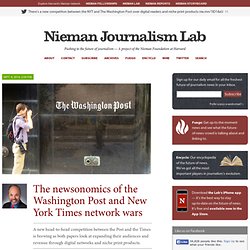
The Washington Post’s Newspaper Partner Program has grown from a March-planted seedling into a full-grown fall oak. The initiative now includes more than 120 daily newspapers in the U.S., and could connect with more than 200,000 digital newspaper subscribers or more by the middle of next year. Meanwhile, The New York Times is newly working with newspaper partners, launching its own products. Rakuten’s CEO on Humanizing E-Commerce. Photography: Gabriela Hasbun The Idea: Mikitani believes that human beings need communication and connection.
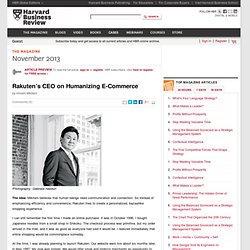
So instead of emphasizing efficiency and convenience, Rakuten tries to create a personalized, bazaarlike shopping experience. When does giving the reader what they want turn into clickbait? It’s complicated. The conventional wisdom is that clickbait is the bane of internet journalism, a kind of desperate pandering by revenue-challenged media companies aimed at racking up eyeballs — driven by the relentless economics of pageview-driven advertising.
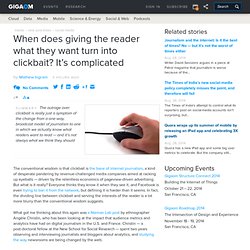
But what is it really? Everyone thinks they know it when they see it, and Facebook is even trying to ban it from the network, but defining it is harder than it seems. Journalism and the internet: Is it the best of times? No — but it’s not the worst of times either. Having just written what I consider a defense of the internet’s effect on journalism and the media industry, I didn’t expect to have to do it again so soon.

But just after Andrew Leonard’s short-sighted piece in Salon about how the internet has crippled journalism, David Sessions wrote on the same topic in Patrol magazine, and arguably did an even worse job of describing the current state of journalism, calling it a morass of “cynical, unnecessary, mind-numbing, time-wasting content.” It’s not just the over-riding pessimism of both of these pieces that bothers me. It’s the failure to appreciate that the complaints they have are the same ones that have been made about journalism for decades — combined with the unrestrained longing for some mythical golden age of journalism. The internet didn’t invent clickbait. Majority Of Digital Media Consumption Now Takes Place In Mobile Apps. U.S. users are now spending the majority of their time consuming digital media within mobile applications, according to a new study released by comScore this morning.
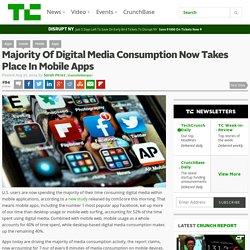
That means mobile apps, including the number 1 most popular app Facebook, eat up more of our time than desktop usage or mobile web surfing, accounting for 52% of the time spent using digital media. Combined with mobile web, mobile usage as a whole accounts for 60% of time spent, while desktop-based digital media consumption makes up the remaining 40%. Apps today are driving the majority of media consumption activity, the report claims, now accounting for 7 our of every 8 minutes of media consumption on mobile devices. 4 tips for adjusting to the tempo of digital news from veteran designer Mario Garcia. The key to telling stories in the digital age is remembering that the news cycle is propelled by two tempos that each require different strategies, veteran news designer Mario Garcia explained at TEDxPoynterInstitute Tuesday.

The tempos, which Garcia calls “24/7″ and “curation,” are different from one another, but every news organization has to pay attention to both to fully serve its audience, Garcia said. He shared some tips, gleaned from four decades of design consulting with 700 news organizations, on how to manage the two storytelling modes. Here are some highlights: 1. Don’t rehash the background of the story. If you’re a media company, your mobile competition isn’t other news entities, it’s Google Now. At conferences — and in editorial meetings, when a visionary speech from management is required — media companies like to talk about how the future of news is mobile.
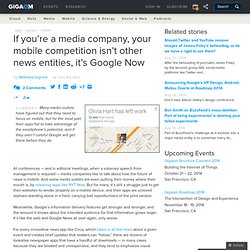
And some media outlets are even putting their money where their mouth is, by releasing apps like NYT Now. But for many, it’s still a struggle just to get their websites to render properly on a mobile device, and their apps are unloved orphans standing alone in a field, carrying bad reproductions of the print version. Is an ad-based business model the original sin of the web — and if so, what do we do about it? Ethan Zuckerman, director of the Center for Civic Media at MIT and co-founder of the blog network Global Voices, argues in a fascinating post at The Atlantic that the “original sin” of the internet was that almost every web business defaulted to an advertising-based business model — and that this in turn led to the privacy-invading, data-collecting policies that are the foundation of companies like Facebook and Google.
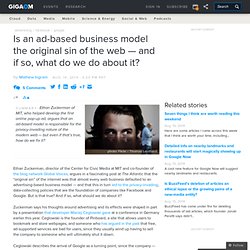
But is that true? And if so, what should we do about it? Turning archives into journalistic goldmines. Media archives is an almost completely unutilized source of information.
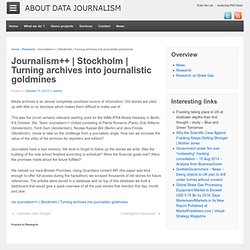
The Internet With A Human Face - Beyond Tellerrand 2014 Conference Talk. Anyone who works with computers learns to fear their capacity to forget. Like so many things with computers, memory is strictly binary. There is either perfect recall or total oblivion, with nothing in between. How the Smartphone Ushered In a Golden Age of Journalism. Oliver munday When I first arrived in New York, some time back in the last century, I gazed in awe and fascination at subway riders reading The New York Times. Thanks to a precise and universally adopted method of folding the paper (had it been taught in schools?) , they could read it and even turn its pages without thrusting them in anyone else's face. 5 tips for news writing with mobile eyes in mind. 13 August 2014 · by Peter Marsh The way readers consume news has changed.
Media companies must change the way they write and deliver content to address this new trend. In 2010, the Financial Times had no mobile audience. Four years later, more than 60% of FT readers access its content via mobile devices. Today in France, smartphones account for more than 40% of Le Monde’s readers, with 1.9 million monthly visitors using the newspaper’s mobile app.
And, in a recent survey of U.S. consumers conducted by the Associated Press and the American Press Institute, 78% say they used their smartphones to get news during the past week. Some people, especially those in the 18-34 age group, prefer mobile devices as their exclusive source for news content. Unoriginal sin. The amazing Ethan Zuckerman argues at eloquent length in The Atlantic that advertising was the web’s original sin, which really is just a corollary to the contention that giving away content for free on the web (and supporting it with advertising) was newspapers’ and magazines’ original sin. I’m going to disagree. What bothers Ethan, I think, is not advertising but mass media economics — which, I will agree, do not fit on the net. And the solution that preachers against this sin bless — consumer payment — brings with it a host of unintended and unfortunate consequences. Ethan amusingly confesses his role as a serpent in the Garden when he was an early staffer at Tripod and not only introduced advertising support as a means of providing a free homepage service, and not only created the means to target ads to users but also — damn them!
— invented the pop-up ad. Turning archives into journalistic goldmines. Recycle, reuse ... re-publish? Publishers make what's old new again. The Internet With A Human Face - Beyond Tellerrand 2014 Conference Talk. Build on brands, not format: UM CEO. The newspaper industry needs to stop labelling itself as a format and focus instead on the news and information it has to offer if it is to remain relevant to consumers, UM agency chief executive Mat Baxter has said. Ahead of his appearance at the Future Forum next week, Mr Baxter said a more channel agnostic approach was needed – and that extended to the way the industry described itself. He said the most powerful thing newspapers had were masthead brands, with deep and trustworthy relationships with their readers built through the provision of strong news, information and opinion.
“The relationship wasn’t with the format, it was with the brand. The newspaper industry needs to reframe the business it is in.” Many in the industry were still yet to understand that consumers do not care about the medium. “Whether that content exists on channel A, B or C, as long as it’s convenient, timely and good quality, consumers want it. “They dip in and out of a brand experience. Related. 2013 UK CMR COMPILED LE SC.docx - 2014_UK_CMR.pdf.
6 things publishers need to know about UK media consumption, from Ofcom's latest report. The dust has by no means settled when it comes to the changing mix of devices and methods people in the UK use to consume content, if Ofcom's latest communications market report is anything to go by. National newspaper industry working on new system of audience measurement. The national newspaper industry has launched a review into current metrics for audience measurement in a bid to establish a system that tracks readership across various digital platforms. Newsworks – the marketing body for national newspapers – will oversee the appointment of a strategy consultant to head up the process, which follows consultation with advertisers and media agencies, while a statutory 18-month notice period has now been served on the National Readership Survey, which operates the industry’s current measurement system.
García Media → More validation for the two tempos for storytelling in a digital world. Presse: top 10 des tendances à ne pas suivre « Le lab de Mediatype.be. C’est décidé, désormais j’applique les remèdes miracles censés sauver la presse en ligne. Puisque Buzzfeed et Melty sont officiellement devenus des « sites d’info », et donc des exemples à suivre, je m’incline et je pars à la chasse aux clics à m’en faire péter le serveur! Du Flac au Mp3, la genèse d’une conversion Soyons tout à fait honnête, je n’ai pas vraiment le choix, c’est ça ou je perds mes piges pour Mediatype.be. La semaine dernière, alors que je codais un algorithme destiné à faire tourner une app d’investigation journalistique pour Google Glass, j’ai craqué le mot de passe du TamTam d’un des actionnaires de ce blog et voici ce que j’ai découvert: OJD : Le Figaro et Les Echos progressent en mai. En mai 2014, Le Figaro et Les Echos ont enregistré une hausse notable de leur diffusion, selon les déclarations déposées mensuelles (DDM) de l'OJD.
Ainsi, Le Figaro progresse-t-il de +3,01% sur la période vs 2013, à 325 794 exemplaires. Les Echos, quant à eux, enregistrent une hausse de +2,83% (127 028 exemplaires) tandis que Le Monde reste stable (-0,03%) en mai 2014 vs mai 2013, avec 274 839 exemplaires. For-email-a-death-greatly-exaggerated. Photo. What "media multitaskers" look like and why you should care. Joshua Benton on Journalisms Digital Transition. This Week in Review: Reasons for optimism about journalism, and how far to take traffic-chasing. Comment The Atlantic a-t-il doublé le nombre de ses journalistes en 5 ans ?
Même datant du 19ème siècle, sans mur payant en ligne, diffusé en entier gratuitement sur le web, et sans lol cat, le magazine américain The Atlantic est parvenu à multiplier par deux la taille de sa rédaction depuis 2009 et à gagner de l’argent depuis 2010. En cinq ans, son trafic en ligne a fait un bond de 80% pour atteindre 25 millions de visiteurs uniques par mois sans compromis sur la qualité. Thoughts on the media future: N.Y. Times’ David Carr, BuzzFeed’s Ben Smith, MSNBC’s Andrea Mitchell - Shorenstein Center - Shorenstein Center. Four key questions that will determine the future of news. Despite the recent flurry of activity like Jeff Bezos buying the Washington Post and investing in Business Insider, Pierre Omidyar starting First Look, Flipboard’s acquisition of Zite, and new products like Facebook Paper and Yahoo News Digest, fundamental questions remain about the future of news: 1.
What will digital life look like in a decade? Some predictions, from the optimistic to mind control. Un « Netflix du livre » a-t-il une chance de réussir ? Maybe news is just more efficient. 5 ways startups are narrowing the content discovery gap. A new consensus on the future of news. Content vs. service — Whither news? There are no journalists — Whither news? CMS as Media Salvation. Not. — Whither news? Too much news — Whither news? Engagement, collaboration, and membership — Whither news? MetaMediaFTV7 SCREEN. Is History Repeating Itself? BuzzFeed’s Jonah Peretti Goes Long — Matter. Deloitte. Chiffres clés - Enquête rapide 2012. Chasing sustainability on the net 2012. CMI Discussion Paper Circulation Trends 102813.
Digital News Report 2013. Print Chapter State of the Media - digital. Print Chapter State of the Media - newspapers. Print Chapter State of the Media - overview. Rapport Lescure. Reuters Institute Digital News Report 2014 - Full Report (low resolution)-GBC. The 25 Most Popular Nieman Lab Stories of 2013. The State of the Digital News Publishing Industry, According to the Internet. Scobble et Gary aux TV : pas de romantisme, montez des commandos ! L’avenir effrayant de la surveillance par les drones. Can Print Magazines Save Themselves? - Peter Osnos. Why Websites Are to News What Compact Discs Were to Music. Ethan Zuckerman. Day-old news won’t cut it in print anymore. The newsonomics of how the news industry will be tested in 2014. The big picture: Mass media era was the blink of an eye. Bloomberg's Justin Smith's Blueprint for Modern Media. » Why We Need the New News Environment to be Chaotic Clay Shirky. » Newspapers and Thinking the Unthinkable Clay Shirky.
La presse française depuis 1631. Sorry, Jeff Bezos, the news bundle isn’t coming back. Will the Internet Unbundle Higher Education Too? Mark Thompson : « Au New York Times, on ne voit pas le Net tuer le papier », Interviews. Printed newspapers go out of fashion but have a legacy value. Presse : le numérique prend le relais du papier. What FT’s success says about the future of newspapers. Cahier de Tendances médias : édition automne – hiver. The newsonomics of outrageous confidence. Newspapers put together by one person 'skimming online content' - Montgomery's leaked Local World vision document.
Blog Archive » The Web’s third frontier. The Rights of Journalism and the Needs of Audiences. Ona2013. Google’s chief economist understands media better than some industry executives do. Crise de la presse : une information à deux vitesses. La fin des journaux selon Bernard Poulet. Bernard Poulet s'explique sur «la Fin des journaux» Des quotidiens payants pour les riches. Cooperation in a Peer Production Economy: Experimental Evidence from Wikipedia. If Readers Change How They Consume It. Time to change the pace. New rule: Cover what you do best. Link to the rest. Sulia Raises ~$5 Million. La crise de la presse ? Mais quelle crise ? Réjouissons-nous !
La revue est-elle le futur du journalisme ? Entretien avec Adrien Bosc, fondateur de Feuilleton. Putting the bundle back together? The newsonomics of The Guardian’s new “Known” strategy. Rise of the Platishers. The newsonomics of why everyone seems to be starting a news site. The newsonomics of momentum in the WSJ/NYT battle. Les médias, nouveaux incubateurs de start-ups ? News as Exploration, Discovery and Serendipity. 7 tendances qui devraient préoccuper les médias en 2014.